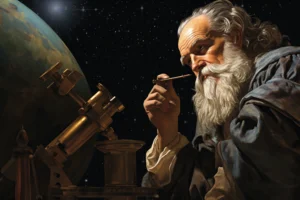Learn the reason for which it is said that certain Zodiacal degrees never rise within the polar regions.

Uranus, Neptune, and Pluto: like Mercury, Venus, and Mars?
septiembre 29, 2023
Autor: David Bustamante S.
Let us learn the difference between symbol and scope to better understand the true difference between the former and the latter.
“A false science makes atheists; a true science defers man to divinity.” François-Marie Arouet, or Voltaire (1694-1778)
Much is discussed about including or excluding the three celestial bodies beyond restrictive and limiting Saturn, that is, disruptive Uranus, chaotic Neptune, and deadly Pluto, from astrological analysis or delineation, as the ancients did not take them into consideration, either because they were not visible to the naked eye or because, for that reason, they were unaware of their existence. Regardless of the criterion (whether they are visible to the naked eye or if they exist, period) we should be clearer about the symbols.
Uranus, Neptune, and Pluto do not constitute symbols or significations different from those attributed to Mercury, Venus, and Mars, respectively, and we must know these well first in order to better understand the ones originally mentioned. The seven traditional celestial bodies represent the seven major experiences of human species on Earth and the subsequent three do not go beyond them with regard to the symbol but to the scope instead. If Mercury, for example, represents transmission and interaction, exchange and interpretation, in short, the brain’s synaptic capacity (from which aforementioned functions emerge), Uranus will not represent anything different, but its scope in relation to said symbol will be much greater. Thus, from a strictly cognitive or neurological point of view, Uranus’ synaptic capacity is much more developed and allows us to associate it with a phenomenon that neurologists have named “gyrification“ [1], according to which the folds of our cerebral cortex, that is, its contortions (an emphasis must be made on word: contortion) make possible much greater information processing speeds, which is why good or poor gyrification can explain both intellectual gifts and cognitive disorders (emphasis again: disorder). Such disorders include or may include epilepsy, schizophrenia, autism, and more, including ADHD, without that meaning to say that the Moon and Mercury, especially if affected, cannot shed light on the matter as well. (Continue reading below.)
It is possible for this difference (not of the symbol but of its scope) to be better appreciated from a strictly mundane point of view, a context under which the value, convenience, or merit of all three ulterior bodies is better appreciated. Although Mercury is technical and technological, it does not also manage to represent or offer information about phenomena governed by the same principle on a much larger scale: social, technological, and scientific revolutions. The same applies to Neptune and Pluto. The latter are capable of representing more mature planes of the symbol. From a clinical point of view, Uranus, Neptune, and Pluto could be clearer regarding disorders of consciousness in general as the functions already represented by their previous versions go much further (they are outer planets, after all) than what the social order on Earth makes possible. In fact, they are disorders difficult to explain (like these planets), and those who suffer from them, for their part, experience too great difficulties reconciling their reality with the extraordinary reality contained in their consciousness. Thus, great frustrations come about (if not accidents or behavioural aberrations).
Although this will one day help us better understand the human brain, which, in many ways, remains a mystery to neuroscientists (like Uranus, Neptune, and Pluto to us), what’s important here is to understand that they are not different symbols. Understanding it constitutes a fundamental component of the astrologer’s education and should consider them only after mastering the first seven’s semantics. Going forward, our academy will take this position. They will be studied after studying the traditional seven.
______________________________
[1] If you’d like to understand the phenomenon better, watch these videos:











